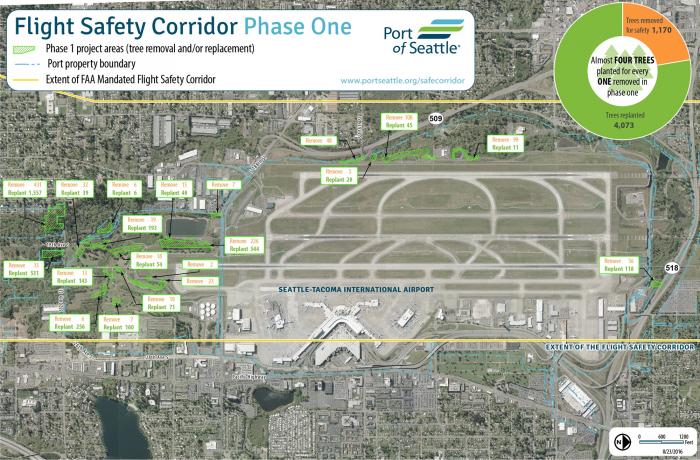By Gwen Davis
The Port of Seattle is set to cut down 2,800 identified trees in SeaTac, Burien and Des Moines. This plan, dubbed the “Flight Corridor Safety Program” is to ensure that planes can take off and land in a way that “safeguards the people at the airport and in the surrounding community”, according to the Port. It is also intended to comply with Federal Aviation Administration (FAA) regulations and state code. The trees will be removed over the course of three years. In phase one, which begins in late 2016, approximately 1,170 trees on Port property will be removed. Alongside the cutting, approximately 4,000 trees will be planted to compensate for the trees lost.
In subsequent phases, trees will be removed on publicly owned, commercial and residential properties. The full plan can be viewed on the Port’s website.
“The airport needs to survey the area for obstructions every four years and in 2014 we did just that,” said Stephen St.Louis, Port operator. “It’s not about clearing places for the pilots to see, it’s about the safety of the passengers.”
If something goes wrong within the course of landing, there needs to be space for planes to make alternate plans, he said. If the runways have obstructions, the FAA can penalize the airport.
While the FAA is not mandating that the trees be cut down, the Port said it needs to work with the association.
“The FAA is pretty much telling us that this has to be done,” said Port senior media relations official, Perry Cooper. “If these requirements aren’t followed the runway may have to be shut down.”
“The FAA does audits our operations every year,” he continued. “We work with them.”
Additionally, the Port said that this plan is not only about abiding by federal regulations, but by state regulations, as well. Airport hazards are contrary to public interests according to Washington State code.
But replanting trees is paramount to the plan, Port officials stated.
“The objective is never to have to touch the trees after this,” St.Louis said.
Steve Rybolt, environmental program manager at the Port explained that the new vegetation will be chosen strategically.
“We will put in specific species that are low-growing or are low-height species,” he said. “We have our species identified on our website.” Species include red alders and Oregon ash. All the species will also be native to the area. “We will not just replant trees, we will also replant shrubs for undergrowth.”
Currently, the trees that will be removed include a mix of native and non-native species, Port officials said.
Rybolt said that following phase one, the Port will have to work with the cities, jurisdictions and residents who own the trees. All tree-owners will be notified in advance that their trees will be cut down. Port officials will also need to personally negotiate with them about which species of trees will be replanted.
“In phase 3 we’ll be working with residential property owners,” he said. “They’ll be notified in advance, and each property will be worked with uniquely.”
“We’re going to have to work with them to really understand what they want, but also what we need,” he continued.
However, there will be limits to replant requests. For example, “a Douglas fir might not work,” he said.
“We want to try to replant trees where they were removed.”
A tree bank might be created.
So far, for the first phase, 1,800 residents received a letter that a tree close to them might be impacted by the plan. The letter wasn’t specific in indicating which tree would be cut. Receivers of the letter were encouraged to call the Port for more information.
“We will do that again for phases 2 and 3,” Cooper said. “Once we get closer to phase 3 we will reach out to each property owner. We will not randomly show up without prior notification. Additionally, even before that happening, we will have meetings and involve the city.”
Cooper said the Port had an open house about the project in April.
Continued community discussion is planned.
The Port has gone through an environmental review process regarding the impacts of phase one, and it was determined that the impacts were of nonsignificance. However, the Port will have to go through environmental review processes for subsequent phases.
Moreover, arborists have determined that removing the trees is the only way to solve the problem.
“We had an arborist consultant do a lot of field work for us,” Rybolt said. “Topping of trees is not a recommended process. As soon as you top the tree, the tree will die and it will become a hazard.”
There was speculation that the tree-cutting served more than one purpose. The airport is planning to expand in the northern terminal, and residents wondered if cutting the trees would be advantageous to that end, since there might be more room for expansion. However, Port officials said the two had nothing to do with each other.
“There’s no correlation between cutting the trees and expanding the airport,” Rybolt said. “Whether we expand the airport or not, these trees will still have to be removed. There are also no obstructions to where the northern terminal will be located.”
